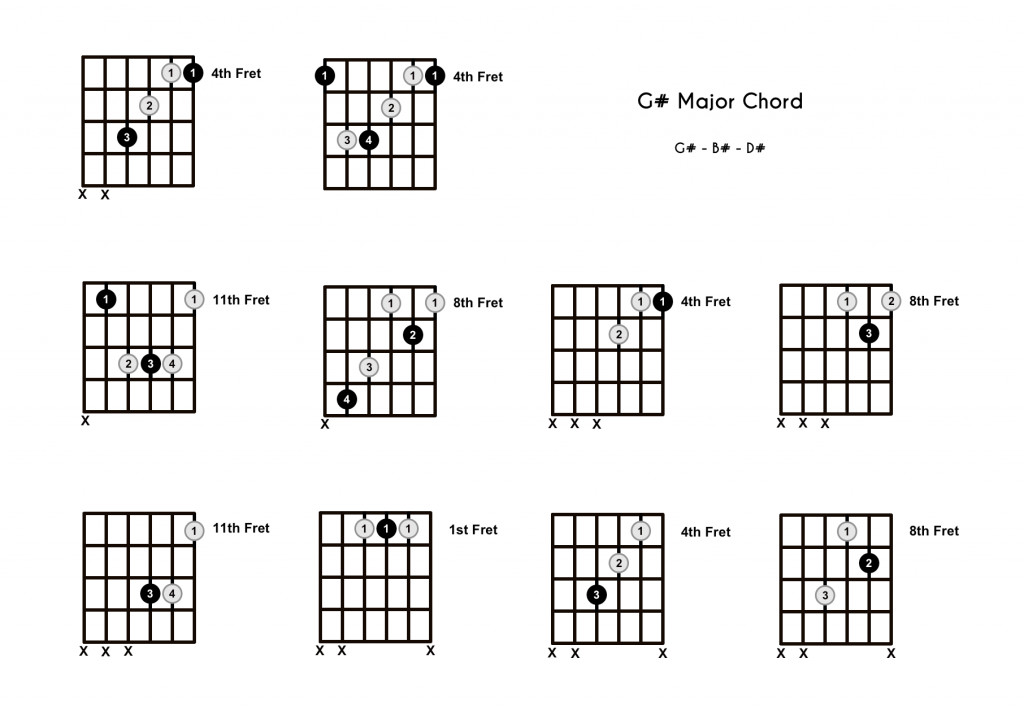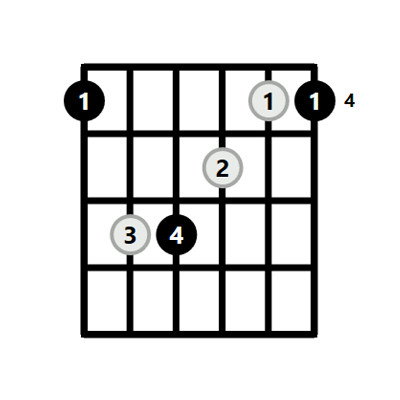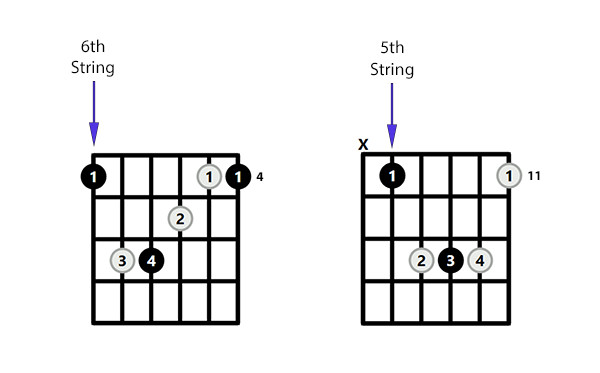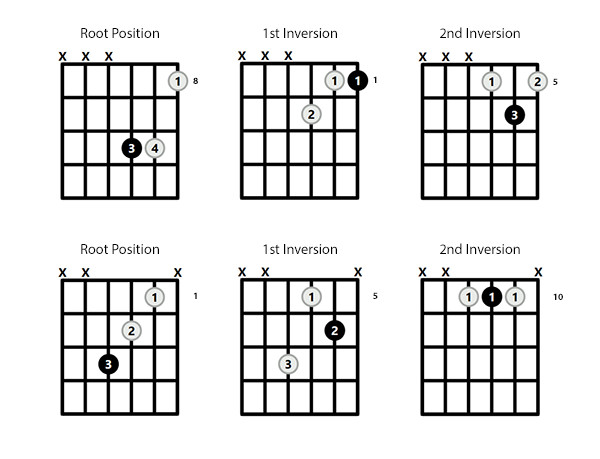The G sharp major chord, often seen as the less common sibling to the Ab major chord, is an essential component in understanding guitar chord theory and expanding your fretboard knowledge. While it might not be the first chord you learn as a beginner, the G# chord appears in various musical contexts, particularly depending on the key of a song. Understanding and being able to play the G Sharp Guitar Chord will enhance your versatility as a guitar player.
Delving into G# Chord Theory
To truly grasp the G# major chord, it’s beneficial to understand some basic music theory. Let’s break down the essentials:
- Notes in the G# Major Chord: The G# major chord is composed of three notes: G#, B#, and D#.
- Construction from the G# Major Scale: This chord is built upon the G# Major scale, using the 1st (root), 3rd, and 5th degrees of the scale.
- Interval Pattern: Like all major chords, the G# chord follows a specific interval pattern from its root note: Major 3rd, minor 3rd, and Perfect 4th (returning to the root in the next octave).
- Position in the Key of G# Major: The G# major chord is the tonic or I chord in the key of G# Major. The complete set of chords in the key of G# major includes: G#, A#m, B#m, C#, D#, E#m, and Fx diminished.
This theoretical foundation helps you understand the musical context and construction of the G# chord, making it more than just a shape on the fretboard.
Exploring 10 Ways to Play the G# Major Chord
For guitarists seeking visual representations and different voicings, here are 10 shapes for playing the G# major chord on the guitar:
 Diagram showing 10 shapes for the G sharp major chord on guitar fretboard
Diagram showing 10 shapes for the G sharp major chord on guitar fretboard
The Standard G# Barre Chord Shape
The most frequently encountered way to play the G# chord is using a root-6 barre chord shape. This involves barring across the 4th fret. Being a barre chord, it requires some finger strength and dexterity, which might make it a bit challenging for absolute beginners. However, mastering this shape is crucial as it’s transferable across the fretboard for other major chords.
 Image of a hand playing the standard G sharp barre chord on a guitar
Image of a hand playing the standard G sharp barre chord on a guitar
The Easier G# Chord Shape
For a less demanding alternative, especially when transitioning from open chords, the “easy” G# chord shape is a great option. This shape is derived from the open A chord shape, but shifted down one fret and played without any open strings. Moving the A chord down a fret results in Ab, which is enharmonically equivalent to G#. This shape is simpler because it only involves fretting three strings, making it more accessible than the full barre chord.
 Image of a hand playing the easy G sharp chord shape on a guitar
Image of a hand playing the easy G sharp chord shape on a guitar
Step-by-Step Guide to Playing the Standard G# Major Chord
If you’re unsure about finger placement for the standard barre chord, follow these step-by-step instructions:
- Barre: Place your index finger across all six strings at the 4th fret, ensuring each string is pressed down cleanly.
- Third Finger: Position your ring finger on the 6th fret of the 5th string.
- Fourth Finger: Place your pinky finger on the 6th fret of the 4th string.
- Second Finger: Place your middle finger on the 5th fret of the 3rd string.
- Strum: Strum all six strings from the low E string to the high e string.
Following these instructions methodically can help you confirm you are forming the chord correctly and troubleshoot any issues you might be encountering.
Utilizing Barre Chord Shapes for G Sharp
Beyond the standard shape, the G# chord can be formed using different barre chord positions. You can play it as a root 6 barre chord starting at the 4th fret (as discussed) or as a root 5 barre chord major shape starting on the 11th fret. Exploring both root 6 and root 5 barre shapes expands your ability to play G# and other major chords across the neck.
 Image showing different G sharp barre chord shapes on guitar
Image showing different G sharp barre chord shapes on guitar
G# Major Triads and Inversions
While standard chord shapes are common, understanding triads and inversions offers a deeper exploration of chord voicings. A triad is a three-note chord, and inversions change which note is in the bass. The G# major triad can be voiced in three primary ways:
- Root Position: G# – B# – D# (Root note is G#)
- 1st Inversion: B# – D# – G# (Third of the chord, B#, is in the bass)
- 2nd Inversion: D# – G# – B# (Fifth of the chord, D#, is in the bass)
Here are visual representations of six different ways to play G# major triads, including these inversions, across the guitar fretboard.
 Diagram showing different G sharp major triad shapes on guitar fretboard
Diagram showing different G sharp major triad shapes on guitar fretboard
Keys Where the G Sharp Chord Appears
Knowing which keys contain the G# chord can help you anticipate its use in songs and compositions. The G sharp chord naturally occurs in the following keys:
- G# Major: As the tonic chord.
- C# Major: As the IV chord.
- D# Major: As the III chord (minor key context).
- E# Major: As the II chord (minor key context).
Understanding these key relationships is valuable for songwriting, improvisation, and analyzing chord progressions.
Alternative and Useful G Sharp Chord Shapes
Beyond the common shapes, several alternative G# major chord shapes can offer different voicings and ease of playing in specific musical situations. These might not be your go-to shapes, but they are useful additions to your chord vocabulary for adding variety and texture to your playing.
G# Chord Substitutions
In certain musical contexts, you can substitute the G# major chord with related chords to create interesting harmonic variations. Effective substitutions for the G# chord include:
- G#sus4 Chord: Adds a suspended fourth for a slightly unresolved sound.
- G#sus2 Chord: Adds a suspended second for a brighter, more open sound.
- G#add9 Chord: Adds the 9th for a richer, more complex major sound.
Furthermore, the G# major chord itself can often act as a substitution for more complex chords that have G# as the root, such as the G# Major 7 chord or the G#7 chord, and other extended chords rooted on G#. However, it’s important to note that G# major cannot substitute for minor chords.
Scales to Play Over the G# Chord
For soloing and improvisation over a G# major chord, or for crafting melodies in songwriting, several scales are particularly effective:
- G# Major Scale: The most fundamental choice, naturally outlining the chord tones.
- G# Major Pentatonic Scale: A simpler, five-note scale derived from the major scale, great for melodic ideas.
- G# Lydian Mode: A major scale mode with a raised 4th, creating a brighter, more expansive sound.
Experimenting with these scales will unlock melodic possibilities and enhance your improvisational skills over the G# major chord.
Further Exploration
To deepen your understanding and application of the G# major chord, explore these related resources:
- G# Major scale
- Comprehensive guide on How Major chords work
- Explore a wide range of guitar chords on our main Chords page
- Learn the G# Major arpeggio
- Discover voicings for the G#/B# chord
- Understand slash chords like the G#/D# chord
 Promotional banner for Get Guitar Chords Galore eBook
Promotional banner for Get Guitar Chords Galore eBook
By mastering the G sharp guitar chord and understanding its theoretical underpinnings, you’ll significantly expand your musical vocabulary and guitar playing proficiency. Practice these shapes, explore the scales, and experiment with substitutions to fully integrate the G

